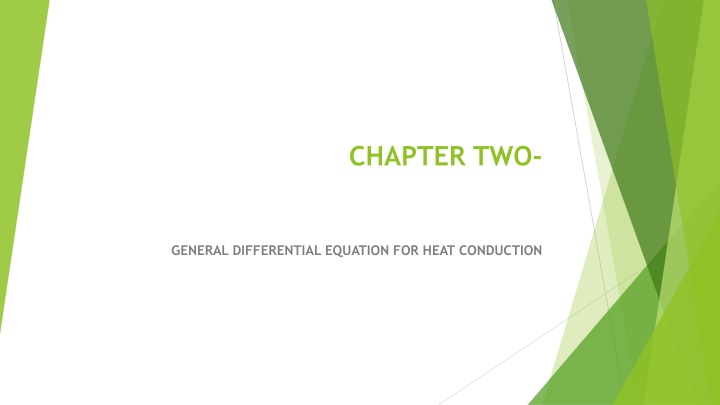
Differential Equations for Heat Conduction in Different Coordinates
Explore the general differential equations for heat conduction in Cartesian and cylindrical coordinates, along with steady state conditions and Laplace equation. Fourier's law of heat conduction and the thermal diffusivity are discussed, providing a comprehensive overview of heat conduction principles.
Download Presentation

Please find below an Image/Link to download the presentation.
The content on the website is provided AS IS for your information and personal use only. It may not be sold, licensed, or shared on other websites without obtaining consent from the author. If you encounter any issues during the download, it is possible that the publisher has removed the file from their server.
You are allowed to download the files provided on this website for personal or commercial use, subject to the condition that they are used lawfully. All files are the property of their respective owners.
The content on the website is provided AS IS for your information and personal use only. It may not be sold, licensed, or shared on other websites without obtaining consent from the author.
E N D
Presentation Transcript
CHAPTER TWO- GENERAL DIFFERENTIAL EQUATION FOR HEAT CONDUCTION
GENERAL DIFFERENTIAL EQUATION FOR HEAT CONDUCTION 1.1 General differential equation for heat conduction in Cartesian coordinates We can write it mathematically as ??? ????+ ????= ??? .1 where, ???= energy entering the control volume per unit time. ????= energy leaving the control volume per unit time. ????= energy generated within the control volume per unit time ???= energy storage within the control volume per unit time
???= ?? + ?? + ??.2 ????= ??+??+ ??+??+ ??+?? .3 Now, from calculus, we know that ??+??etc. can be expressed by a Taylor series expansion, where, neglecting the higher order terms, we can write, ??+??= ??+??? ?? ??+??= ??+??? ?? ??+??= ??+??? ?? ????= ????.??.?? .5 .?? .4.1 .?? .4.2 .?? .4.3 ?? ?? .6 ???= ?.?? ?? ??.?? Now, substituting for all terms in Eq. 1, we get, ??? ????+ ????= ??? ?? ?? ??+ ??+ ?? ??+??+ ??+??+ ??+?? + ????.??.?? = ?.?? ?? ??.?? ??? ?? ?? ?? .?? +??? .?? +??? ?? ???? ?? ?? ..7 .?? + ????.??.?? = ? ??
Now let us bring in Fourier's law of heat conduction. ?? ??= ??????? ?? ??= ??????? ?? ??= ??????? ??= ??? ?? 8.1 ??= ??? ?? 8.2 ??= ??? ?? 8.3 Substituting Eq.(8), in Eq.(7), and dividing by ??.??.??, we obtain, ? ?? ??? ?? ? ?? ??? ?? ??2+?2? +? ??? ?? ?? ?? + + ??= ? ?? ?? ?2? ??2+?2? ?? ?? ? + ??= ? ?? ??2 ?2? ??2+?2? ?2? ??2+?2? ??2+?2? ??2+?2? +?? ?=? ?? +?? ?? ??=1 ?? ?? 9 ?? ?? ??2 ? ? ?=1 ??2 ? Where, ? = ? ???is thermal diffusivity.
Steady state: This means that the temperature at any position does not change with time, i.e. ?? ??= 0 Eq.9, becomes: ?2? ??2+?2? ??2+?2? +?? ?= 0 ??2 With no Internal heat generation: This means that qgterm is zero. So, Eq. 9 becomes, ?2? ??2+?2? ??2+?2? =1 ?? ?? ??2 ? Steady state, with no Internal heat generation: This means that qgand ?? ??are zero. So, Eq. 9 becomes. ?2? ??2+?2? ??2+?2? = 0 ??2 This is known as Laplace equation, and it represents steady state, three-dimensional heat conduction with no internal heat generation, with constant thermal conductivity, in Cartesian coordinates. One-dimensional, steady state, with no internal heat generation: This means that. ?2? ??2=?2? ?? ??= 0 ??2= 0 , ??= 0 ??? So Eq. 9 becomes, ?2? ??2
1.2 General differential equation for heat conduction in cylindrical coordinates ? = ? ??? ? = ? ??? ? = ? = ??? 1 ? ? The resulting general differential equation in cylindrical coordinates is, ?2? ? 2+?2? ??2+?? 1 ? ? ?? ??? ?? +1 ?=1 ?? ?? 10 ?2 ?
General differential equation for heat conduction in spherical coordinates? = ? ???? ??? ? = ? ???? ??? ? = ? ???? The resulting general differential equation in spherical coordinates is, ?2? ? 2+?? 1 ? ? ?? ?2?? 1 ? ?????? 1 ?=1 ?? ?? ..13 + + ?2???? ?2???? ?? ?? ?? ?
